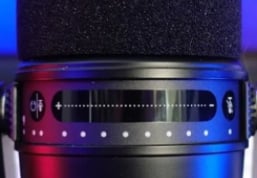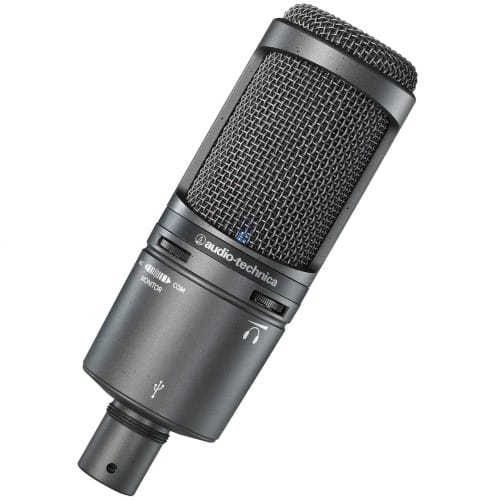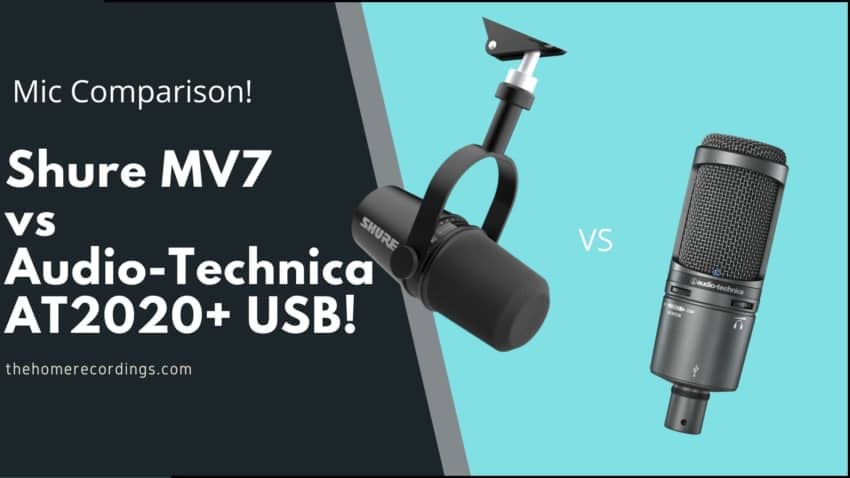Last updated on December 29th, 2023 at 09:53 pm
Both Shure and Audio-Technica are extremely well-known brands in the music industry, and the AT2020 has been around for years and become a staple in the industry, whereas the Shure MV7 has only been released about a year ago and comes with more modern features.
In this article, I will be going over their differences, their pros & cons, how they sound, their ease of use, the included software (if they have any), and much more.
So, without any further ado, let’s get started!
In short, here are the differences between the Shure MV7 and the Audio-Technica AT2020+ USB: The Shure MV7 is a dynamic microphone that features both USB and XLR connections, a touch pad to control the volume, and a software for further adjusting the sound. The AT2020+ USB only comes with a USB connection, making it less versatile, and the dials used to adjust the volume are more difficult to read.
So, let’s get this show on the road, shall we?
Shure MV7 Overview

The Shure MV7 is a relatively new mic that seems to have been designed to bridge the gap between the more affordable USB microphones and the almighty SM7B, which is the standard podcasting mic that sells for roughly $400.
The Shure MV7 looks very similar to the SM7B and it’s also a dynamic microphone, which is not that common for USB microphones since most of them are condensers, and this means that it generally won’t pick up as much background noise, making it a good choice for anyone who is running a podcast or gaming at home where there might be some noise.
The most important feature of the Shure MV7 is that it not only features a USB connection, but an XLR one as well, and if you read any of my other USB mic-related articles then you probably know that, while I like USB mics and I think that they have their place, they don’t offer an upgrade path and you will end up spending a lot more once you move on to a more professional setup.
With the Shure you can simply buy a Mixer or an Audio Interface and won’t have to worry about not being able to use it since you can simply connect it to the mixer using an XLR cable.

Another distinctive feature is its interactive touch panel on the top which lets you control the audio level, the monitor mix, and you can tap it to mute/unmute the mic and the headphones. While I do think that this is a really modern way of doing things, I don’t know if a touch panel will last longer than knobs, so we’ll have to wait and see.
Lastly, it comes with the ShurePlus MOTIV software which comes with a lot of features that podcasters and gamers are going to enjoy, such as:

- Control the gain automatically or do it manually.
- Change the tone from Dark to Natural or Bright.
- Adjust the monitor mix.
- Adjust the audio “view” of the mic, such as “Near” and “Far”.
- Manual mode lets you adjust the gain, the monitor mix, it offers some basic EQ, a limiter, and a basic compressor.
The EQ and compressor only offer basic settings that you can turn on or off, like High-Pass filter, presence boost, etc., and don’t really give you a more granular control over the signal.
The Limiter is an excellent feature to have, especially for podcasters and gamers, since they prevent loud audio spikes, which could easily jump scare your audience.
What comes in the box?
- Shure MV7 USB/XLR Microphone.
- Micro USB to USB-C cable.
- Micro USB to USB-A cable.
Features
- USB and XLR connections.
- Touch Controls (no knobs).
- Dynamic microphone (better for background noise).
- ShurePlus MOTIV software for better control over the audio signal.
How does it sound?
This mic reminds me a lot of the way the Shure SM7B sounds, especially in the low end since it makes your voice sound deep and really full, which is why I think that it’s especially good for podcasters. Other than that, it sounds really balanced and I don’t think that there’s anything that stands out as “bad”, like no frequencies poking their head out too much.
As far as recording music goes, it actually surprised me quite a lot since recording my acoustic guitar sounded full but not boomy, and the higher end had a nice open airy sound to it. Overall, quite impressed.
One thing that I don’t particularly like, however, is the foam pop filter, especially for being such an expensive microphone, since I feel like it doesn’t really do that much in terms of reducing the plosives. It’s super thick on the sides but the top is extremely thin (hold it up against a light and you can almost see right through it).
I don’t know why they went with this design, maybe a thicker pop filter affected sound quality? I don’t know, but it doesn’t work as well as I would’ve hoped.
So, either offset it when recording (off axis) and see if you like how it sounds, or find a way to put a pop filter in front of it.
Also, it doesn’t come with a built-in shock mount, so taping on the desk, keyboard, or just accidentally bumping against the boom arm/tripod, will transmit all of that vibration into the mic.
Specifications
- Polar Pattern; Cardioid
- Connectivity: XLR and USB
- Frequency Response: 20Hz- 20kHz
- Sample Rate: 44.1/48kHz/16/24-bit
- Max SPL: 132dB
- Weight: 550g
Get the Shure MV7 here.
- Shure MV7: Amazon, Sweetwater, Guitar Center.
Audio-Technica AT2020+ USB

There are few better-known brands in the music industry than Audio-Technica. They make some of the best microphones available on the market and the AT2020 is the go-to mic for almost every beginner home recording enthusiast, plus you won’t see a studio that doesn’t have at least a couple of them.
The USB version of the Audio-Technica AT2020 is just as good as the XLR AT2020 with the advantage of being a plug n’ play microphone that works both on Windows and Mac OS without the need of installing any sort of driver.
It comes with a built-in headphone jack and a volume control that allows you to directly monitor what is being recorded with no delay (Zero latency). It also offers a mix control that blends the microphone and the pre-recorded audio.
The controls on the AT2020 aren’t as easy to use as I would have liked, and this is something that is definitely easier to do on the Shure MV7 because of the touch display that shows the level you’re at in a clear way.
As far as build quality goes, the AT2020+ is extremely well built: When holding it in my hand it doesn’t feel like a cheap product at all, quite the opposite in fact. I have to give props to Audio-Technica here since I’ve never tried a mic of theirs that doesn’t feel extremely solid (same goes for Shure, however. Two extremely good brands).
Lastly, the AT2020+ can be used for anything voice related, recording music, YouTube videos, etc.
How does it Perform?
Since the AT2020 is a plug n’ play microphone, you should have absolutely no issues getting it to work; simply connect it and that’s it, you can now record!
The sound quality is excellent, and I mean excellent, especially considering the price, since you probably won’t find another USB microphone at this price range that sounds this good (maybe the Elgato Wave 3, but that one is made of plastic).
The only thing I don’t like that much is that it can sound a bit crispy at times, but that isn’t that much of an issue really since you can fix that with just a bit of EQ afterwards.
I often refer to the AT2020+ as my top recommendation for anyone who is looking for a cardioid condenser USB microphone simply because of the overall sound quality and price.
It records vocals extremely well and I believe that recording voice-related audio is where this microphone really shines.
Of course, it can be used for recording acoustic and classical guitars as well, which is what I used it for before getting some of the other microphones I own.
One big con though is that when recording an overdriven electric guitar it may take you a while to fine-tune the tone and to find the correct mic position, and this is an issue that I had since it took me over 10 min to get a decent tone out of it, and I still didn’t quite like it.
Everything else sounded fantastic!
There’s a reason why the AT2020 (XLR Version) is part of almost every music studio, and that is because when taking cost-effectiveness into account, there are few microphones that can stand up to it.
The USB version is just as good, a bit more expensive, but it doesn’t require you to purchase a separate audio interface!
Related: Here’s a post where I compare the Blue Yeti to the AT2020+, should you be interested.
What do you get in the Box?
- The Audio-Technica AT2020+ USB microphone
- Tripod desk stand
- USB cable
- Storage Pouch
Features
- Headphone Output with volume control
- Tripod desk stand and USB cable included
- Mac and PC Compatible
- Built-in headphone jack
- Mix and Volume Control
Specifications
- Polar Pattern: Cardioid
- Frequency Response: 20Hz- 20kHz
- Sample Rate: 44.1kHz – 48kHz/16-bit
- Weight: 386g
Get the AT2020 USB here: Amazon, Sweetwater, Guitar Center.
Which one should you go for?
The biggest two differences between these microphones are: Price and the fact that the Shure MV7 features an XLR output, making it much more versatile and also more “upgrade-friendly”, since you can get an audio interface and connect it with a regular XLR cable, where the AT2020+ USB would only serve as a door stop.
But since the AT2020+ USB is so much more affordable, about $100, it’s definitely worth considering.
I’d recommend going with the Shure MV7 if you think you’re going to be upgrading your system at some point. If not, go with the AT2020 USB.
Other alternatives
I reviewed a couple USB mics already and there are two that stand out: The ElGato Wave 3 and the Samson G-Track Pro.
The Elgato Wave 3 is a relatively new mic that was designed specifically for gamers since, similar to the Shure in some sense: It comes with included software designed to help you better control the signal (compression, limiter, it lets you manage and mix the level of different audio signals, such as music playing, the stream’s volume, mic volume, etc.).
The ElGato Wave 3 is also much more affordable than the Shure but it doesn’t feature an XLR connection, so if you will never upgrade to a better solution, then this mic may be better for you.
The Samson G-Track Pro is an interesting alternative, mainly for guitarists and bassists since it features an instrument jack that lets you record both the microphone signal and the instrument signal to separate tracks, and you can even use it with amp simulation software with very low latency.
FAQs
Is the Audio-Technica AT2020 good for music? The AT2020 is a standard in the music industry because of how well it records music as well as for how little it costs. Its USB version is just as good, with the advantage of not needing an Audio Interface or Mixer to work.
Is the Audio-Technica AT2020 USB good for Singing? The AT2020 USB is one of the best USB microphones for singing and anything voice-related since it’s got a warm and bright sound without being harsh, and an overall balanced sound signature.
IIs the Shure MV7 good for Singing? The Shure MV7 is an excellent microphone for singing: It has a rich low end without sounding muddy and a nice open high-end without sounding shrill, and since it’s a dynamic microphone, it’s also really good for loud singing and growling.
Is the Shure MV7 good for gaming? The Shure MV7 is an excellent gaming mouse because it’s a dynamic microphone, which means that it won’t pick up as much noise (such as the keyboard noises), and it also comes with a software that lets you enable a limiter to keep the signal from getting too loud, engage an EQ, compressor, and more.
